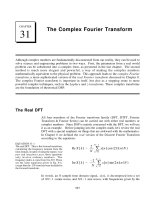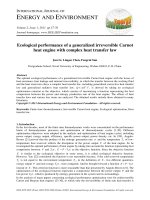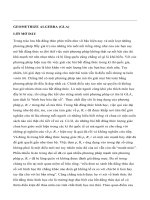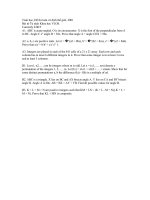mathematics - complex algebra 2001
Bạn đang xem bản rút gọn của tài liệu. Xem và tải ngay bản đầy đủ của tài liệu tại đây (83.73 KB, 15 trang )
Complex Numbers and Functions
______________________________________________________________________________________________
Natural is the most fertile source of Mathematical Discoveries
-
Jean Baptiste Joseph Fourier
The Complex Number System
Definition:
A
complex number
z
is a number of the form
zaib
=+
, where the symbol
i
=−
1
is called
imaginary unit
and
ab R
,.
∈
a
is called the
real part
and
b
the
imaginary
part
of
z
, written
az
=
Re and
bz
=
Im .
With this notation, we have
zziz
=+
Re Im .
The set of all complex numbers is denoted by
{}
CaibabR
=+ ∈
,.
If
b
=
0, then
zai a
=+ =
0,
is a real number. Also if
a
=
0,
then
zibib
=+ =
0, is
a imaginary number; in this case,
z
is called
pure imaginary number
.
Let
aib
+
and
cid
+
be complex numbers, with
abcd R
,,, .
∈
1.
Equality
aibcid
+=+
if and only if
ac bd
==
and .
Note:
In particular, we have
zaib
=+ =
0 if and only if
ab
==
00 and .
2.
Fundamental Algebraic Properties of Complex Numbers
(i).
Addition
()()()().
aib cid ac ibd
+++=+++
(ii).
Subtraction
()()()().
aib cid ac ibd
+−+=−+−
(iii).
Multiplication
()()( )( ).
a ib c id ac bd i ad bc
++=−++
Remark
(a). By using
the
multiplication formula, one defines
the
nonnegative
integral
power
of a complex number
z
as
zzzzzzzz zzz
nn
12 32 1
== = =
−
,, ,, .
!
Further for
z
≠
0,
we define the
zero power
of
z
is 1; that is,
z
0
1
=
.
(b). By definition, we have
i
2
1
=−
,
ii
3
=−
,
i
4
1
=
.
(iv).
Division
If
cid
+≠
0
, then
aib
cid
ac bd
cd
i
bc ad
cd
+
+
=
+
+
+
−
+
22 22
.
Remark
(a). Observe that if
aib
+=
1, then we have
1
22 22
cid
c
cd
i
d
cd
+
=
+
+
−
+
.
(b). For any nonzero complex number
z
, we define
z
z
−
=
1
1
,
where
z
−
1
is called the
reciprocal
of
z
.
(c). For any nonzero complex number
z
, we now define the
negative integral
power
of a complex number
z
as
z
z
zzz zzz zzz
nn
−−−−−−−−−+−
== = =
1211321 11
1
,,,, .
!
(d).
i
i
i
−
==−
1
1
,
i
−
=−
2
1,
ii
−
=
3
,
i
−
=
4
1.
3.
More Properties of Addition and Multiplication
For any complex numbers
zz z z
,, ,
and
12 3
(i).
Commutative Laws of Addition and Multiplication
:
zz zz
zz zz
12 21
12 21
+=+
=
;
.
(ii)
Associative Laws of Addition and Multiplication
:
zzz zzz
zzz zzz
123 123
123 123
++=++
=
()();
()().
(iii).
Distributive Law
:
zz z zz zz
12 3 12 13
() .
+= +
(iv).
Additive and Multiplicative identities
:
zzz
zzz
+=+=
⋅=⋅=
00
11
;
.
(v).
zz zz
+− =− + =
()() .0
Complex Conjugate and Their Properties
Definition:
Let .,,
RbaCibaz
∈∈+=
The
complex conjugate
, or briefly
conjugate
, of
z
is
defined by
zaib
=−
.
For any complex numbers
zz z C
,, ,
12
∈
we have the following algebraic properties of
the conjugate operation:
(i).
zz zz
12 12
+=+
,
(ii).
zz zz
12 12
−=−
,
(iii).
zz z z
12 1 2
=⋅
,
(iv).
z
z
z
z
1
2
1
2
=
, provided
z
2
0
≠
,
(v).
zz
=
,
(vi).
()
zz
n
n
=
, for all
nZ
∈
,
(vii).
zz z
==
if and only if Im ,0
(viii).
zz z
=− =
if and only if Re 0,
(ix).
zz z
+=
2Re ,
(x).
zzi z
−=
(Im),2
(xi).
()()
zz z z
=+
Re Im .
22
Modulus and Their Properties
Definition:
The
modulus
or
absolute value
of a complex number
zaib
=+
,
ab R
,
∈
is defined as
zab
=+
22
.
That is the positive square root of the sums of the squares of its real and imaginary
parts.
For any complex numbers
zz z C
,, ,
12
∈
we have the following algebraic properties of
modulus:
(i).
zz
≥= =
00 0;, and z if and only if
(ii).
zz z z
12 1 2
=
,
(iii).
z
z
z
z
1
2
1
2
=
, provided
z
2
0
≠
,
(iv).
zz z
==−
,
(v).
zzz
=
,
(vi).
zzz
≥≥
Re Re ,
(vii).
zzz
≥≥
Im Im ,
(viii).
zz z z
12 1 2
+≤+
, (
triangle inequality
)
(ix).
zz zz
12 12
−≤+
.
The Geometric Representation of Complex Numbers
In analytic geometry, any complex number
zaibabR
=+ ∈
,, can be represented by
a point
zPab
=
(,)
in
xy-
plane or Cartesian plane. When the
xy-
plane is used in this
way to plot or represent complex numbers, it is called the
Argand
plane
1
or the
complex
plane
. Under these circumstances, the
x-
or horizontal axis is called the
axis
of real number
or simply,
real axis
whereas the
y-
or vertical axis is called the
axis of
imaginary numbers
or simply,
imaginary axis
.
1
The plane is named for Jean Robert Argand, a Swiss mathematician who proposed the representation of complex numbers in
1806.
Furthermore, another possible representation of the complex number
z
in this plane is
as a
vector
OP
. We display
zaib
=+
as a directed line that begins at the origin and
terminates at the point
Pab
( , ). Hence the modulus of
z
, that is
z
, is the distance of
zPab
=
(,)
from the origin. However, there are simple geometrical relationships
between the vectors for
zaib
=+
, the negative of
z
;
−
z
and the conjugate of
z
;
z
in the Argand plane. The vector
−
z
is vector for
z
reflected through the origin,
whereas
z
is the vector
z
reflected about the real axis.
The addition and subtraction of complex numbers can be interpreted as vector
addition which is given by the
parallelogram law
. The ‘
triangle inequality
’ is
derivable from this geometric complex plane. The length of the vector
zz
12
+
is
zz
12
+
, which must be less than or equal to the combined lengths
zz
12
+
. Thus
zz z z
12 1 2
+≤+
.
Polar Representation of Complex Numbers
Frequently, points in the complex plane, which represent complex numbers, are
defined by means of polar coordinates. The complex number
zxiy
=+
can be
located as polar coordinate
(, )
r
θ
instead of its rectangular coordinates ( , ),
xy
it
follows that there is a corresponding way to write complex number in polar form.
We see that
r
is identical to the modulus of
z
; whereas
θ
is the directed angle from
the positive
x-
axis to the point
P
.
Thus we have
xr
=
cos
θ
and
yr
=
sin
θ
,
where
rz x y
y
x
== +
=
22
,
tan .
θ
We called
θ
the
argument
of
z
and write
θ
=
arg .
z
The angle
θ
will be expressed
in radians and is regarded as positive when measured in the
counterclockwise
direction and negative when measured
clockwise
. The distance
r
is never negative.
For a point at the origin;
z
=
0,
r
becomes zero. Here
θ
is undefined since a ray like
that cannot be constructed. Consequently, we now defined the
polar for m
of a
complex number
zxiy
=+
as
zr i
=+
(cos sin )
θθ
(1)
Clearly, an important feature of arg
z
=
θ
is that it is
multivalued
, which means for a
nonzero complex number
z
, it has an infinite number of distinct arguments (since
sin( ) sin , cos( ) cos ,
θπ θ θπ θ
+= += ∈
22
kkkZ
)
. Any two distinct arguments of
z
differ each other by an integral multiple of 2
π
, thus two nonzero complex number
zr i
11 1 1
=+
(cos sin )
θθ
and
zr i
22 2 2
=+
(cos sin )
θθ
are equal if and only if
rr
12
=
and
θθ π
12
2
=+
k
,
where
k
is some integer. Consequently, in order to specify a
unique
value of
arg ,
z
we
may restrict its value to some interval of length. For this, we introduce the concept of
principle value of the argument
(or
principle argument
) of a nonzero complex number
z
, denoted as Arg
z
, is defined to be the unique value that satisfies
ππ
<≤−
z
Arg .
Hence, the relation between arg
z
and Arg
z
is given by
arg , .
zzkkZ
=+ ∈
Arg
2
π
Multiplication and Division in Polar From
The polar description is particularly useful in the multiplication and division of
complex number. Consider
zr i
11 1 1
=+
(cos sin )
θθ
and
zr i
22 2 2
=+
(cos sin ).
θθ
1.
Multiplication
Multiplying
z
1
and
z
2
we have
()
zz rr i
12 12 1 2 1 2
=+++
cos( ) sin( ) .
θθ θθ
When two nonzero complex are multiplied together, the resulting product has a
modulus equal to the product of the modulus of the two factors and an argument
equal to the sum of the arguments of the two factors; that is,
zz rr z z
zz z z
12 12 1 2
12 1 2 1 2
==
=+= +
,
arg( ) arg( ) arg( ).
θθ
1.
Division
Similarly, dividing
z
1
by
z
2
we obtain
()
z
z
r
r
i
1
2
1
2
12 12
=−+−
cos( ) sin( ) .
θθ θθ
The modulus of the quotient of two complex numbers is the quotient of their
modulus, and the argument of the quotient is the argument of the numerator less
the argument of the denominator, thus
z
z
r
r
z
z
z
z
zz
1
2
1
2
1
2
1
2
12 1 2
==
=−= −
,
arg arg( ) arg( ).
θθ
Euler
’s Formula and Exponential Form of Complex Numbers
For any real
θ
, we could recall that we have the familiar Taylor series representation
of
sin
θ
,
cos
θ
and
e
θ
:
sin
!!
,,
cos
!!
,,
!!
,,
θθ
θθ
θ
θ
θθ
θ
θ
θθ
θ
θ
=− + − −∞<<∞
=− + − −∞< <∞
=++ + + −∞< <∞
35
24
23
35
1
24
1
23
!
!
!
e
Thus, it seems reasonable to
define
ei
ii
i
θ
θ
θθ
=+ + + +
1
23
23
()
!
()
!
.
!
In fact, this series approach was adopted by
Karl Weierstrass
(1815-1897) in his
development of the complex variable theory. By (2), we have
ei
iiii
ii i
ii
i
θ
θ
θθθθ
θ
θθθθ
θθ
θ
θθ
θθ
=+ + + +
=+ − − +
=− + + + − + +
=+
1
2345
1
2345
1
24 35
2345
2345
24 35
()
!
()
!
()
!
()
!
!!!!
!! !!
cos sin .
++
++
!
!
!!
Now, we obtain the very useful result known as
Euler’s
2
formula
or
Euler’s identity
ei
i
θ
θθ
=+
cos sin . (2)
Consequently, we can write the polar representation (1) more compactly in
exponential form
as
zre
i
=
θ
.
Moreover, by the Euler’s formula (2) and the periodicity of the trigonometry
functions, we get
.integer allfor 1
, real allfor 1
)2(
ke
e
ki
i
=
=
π
θ
θ
Further, if two nonzero complex numbers
zre
i
11
1
=
θ
and
zre
i
22
2
=
θ
, the multiplication
and division of complex numbers
zz
12
and have exponential forms
zz rre
z
z
r
r
e
i
i
12 12
1
2
1
2
12
12
=
=
+
−
()
()
,
θθ
θθ
respectively.
de Moivre
’s Theorem
In the previous section we learned to multiply two number of complex quantities
together by means of polar and exponential notation. Similarly, we can extend this
method to obtain the multiplication of any number of complex numbers. Thus, if
zrek n
kk
i
k
==
θ
,,,,, 12
"
for any positive integer
n
, we have
zz z rr r e
nn
i
n
12 12
12
!!
!
=
+++
().
()
θθ θ
In particular, if all values are identical we obtain
()
zre re
ni
n
nin
==
θθ
for any positive integer
n
.
Taking
r
=
1 in this expression, we then have
()
ee
i
n
in
θθ
=
for any positive integer
n
.
By Euler’s formula (3), we obtain
()
cos sin cos sin
θθ θ θ
+=+
inin
n
(3)
2
Leonhard Euler
(1707 -1783) is a Swiss mathematician.
for any positive integer
n
. By the same argument, it can be shown that (3) is also true
for any nonpositive integer
n
. Which is known as
de Moivre’s
3
formula
, and more
precisely, we have the following theorem:
Theorem:
(
de Moivre
’s
Theorem
)
For any
θ
and for any integer
n
,
()
cos sin cos sin
θθ θ θ
+=+
inin
n
.
In term of exponential form, it essentially reduces to
()
ee
i
n
in
θθ
=
.
Roots of Complex Numbers
Definition:
Let
n
be a positive
integer
≥
2,
and let
z
be nonzero complex number. Then any
complex number
w
that satisfies
wz
n
=
is called the
n-th root of z
, written as
wz
n
=
.
Theorem:
Given any nonzero complex number
zre
i
=
θ
, the equation
wz
n
=
has precisely
n
solutions given by
wr
k
n
i
k
n
k
n
=
+
+
+
cos sin ,
θπ θπ
22
kn
=−
01 1,, , ,
"
or
wre
k
n
i
k
n
=
+
θπ
2
,
kn
=−
01 1,, , ,
"
where
r
n
denotes the positive real
n
-th root of
rz
=
and
θ
=
Arg
z
.
Elementary Complex Functions
Let
A
and
B
be sets.
A
function
f
from
A
to
B
, denoted by
BAf
→
: is a rule
which assigns to
each
element
Aa
∈
one and
only one
element ,
Bb
∈
we write
)(
afb
=
and call
b
the
image
of
a
under
f
. The set
A
is the
domain-set
of
f
, and the set
B
is the
codomain
or
target-set
of
f
. The set of all images
{}
:)()(
AaafAf
∈=
is called the
range
or
image-set
of
f
. It must be emphasized that both a domain-set
and a rule are needed in order for a function to be
well defined
. When the domain-set
is not mentioned, we agree that the largest possible set is to be taken.
The Polynomial and Rational Functions
3
This useful formula was discovered by a French mathematician,
Abraham de Moivre
(1667 - 1754).
1.
Complex Polynomial Functions
are defined by
Pz a az a z az
n
n
n
n
() ,
=+ + + +
−
−
01 1
1
!
where
aa a C
n
01
,,,
" ∈
and
nN
∈
. The integer
n
is called the
degree
of
polynomial
Pz
( ), provided that
a
n
≠
0.
The polynomial
p z az b
()
=+
is called
a
linear function
.
2.
Complex Rational Functions
are defined by the quotient of two polynomial
functions; that is,
Rz
Pz
Qz
()
()
()
,
=
where
Pz Qz
() () and
are polynomials defined for all
zC
∈
for which
Qz
() .
≠
0
In particular, the ratio of two linear functions:
fz
az b
cz d
()
=
+
+
with
ad bc
−≠
0,
which is called a
linear fractional function
or
Mobius
##
transformation
.
The Exponential Function
In defining complex exponential function, we seek a function which agrees with the
exponential function of calculus when the complex variable
zxiy
=+
is real; that is
we must require that
fx i e
x
()
+=
0 for all real numbers
x
,
and which has, by analogy, the following properties:
ee e
zz zz
12 12
=
+
,
ee e
zz zz
12 12
=
−
for all complex numbers
zz
12
,. Further, in the previous section we know that by
Euler
’s identity, we get
.,sincos
Ryyiye
iy
∈+=
Consequently, combining this
we adopt the following definition:
Definition:
Let
zxiy
=+
be complex number. The
complex exponential function
e
z
is defined
to be the complex number
ee e yiy
zxiyx
== +
+
(cos sin ).
Immediately from the definition, we have the following properties:
For any complex numbers
zz z xiyxy R
12
,, ,, ,
=+ ∈
we have
(i).
ee e
zz zz
12 12
=
+
,
(ii).
ee e
zz zz
12 12
=
−
,
(iii).
, real allfor 1
ye
iy
=
(iv).
,
xz
ee
=
(v).
ee
zz
=
,
(vi).
arg( ) , ,
eykkZ
z
=+ ∈
2
π
(vii).
e
z
≠
0,
(viii).
ezikkZ
z
==∈
12 if and only if (), ,
π
(ix).
ee zzikkZ
zz
12
12
2
==+∈
if and only if (), .
π
Remark
In calculus, we know that the real exponential function is one-to-one. However
e
z
is
not
one-to-one on the whole complex plane. In fact, by (ix) it is periodic with period
i
();2
π
that is,
ee
zi k z
+
=
()
,
2
π
kZ
∈
.
The periodicity of the exponential implies that this function is infinitely many to one.
Trigonometric Functions
From the Euler’s identity we know that
exix
ix
=+
cos sin ,
exix
ix
−
=−
cos sin
for every real number
x
; and it follows from these equations that
ee x
ix ix
+=
−
2cos ,
ee ix
ix ix
−=
−
2sin .
Hence it is natural to define the sine and cosine functions of a complex variable
z
as
follows:
Definition:
Given any complex number
z
, the
complex trigonometric functions
sin
z
and cos
z
in
terms of complex exponentials are defines to be
sin ,
z
ee
i
iz iz
=
−
−
2
cos .
z
ee
iz iz
=
+
−
2
Let
zxiyxyR
=+ ∈
,, . Then by simple calculations we obtain
sin sin cos .
() ()
z
ee
i
x
ee
ix
ee
ixiy ixiy y y y y
=
−
=⋅
+
+⋅
−
+−+ − −
222
Hence
sin sin cosh cos sinh .
zxyixy
=+
Similarly,
cos cos cosh sin sinh .
zxyixy
=−
Also
sin sin sinh ,
zxy
2
22
=+
cos cos sinh .
zxy
2
22
=+
Therefore we obtain
(i).
sin , ;
zzkkZ
==∈
0 if and only if
π
(ii).
cos ( ) , .
zzkkZ
==+∈
02 if and only if
ππ
The other four trigonometric functions of complex argument are easily defined in
terms of sine and cosine functions, by analogy with real argument functions, that is
tan
sin
cos
,
z
z
z
=
sec
cos
,
z
z
=
1
where
zkkZ
≠+ ∈
() , ;
ππ
2
and
cot
cos
sin
,
z
z
z
=
csc
sin
,
z
z
=
1
where
zk kZ
≠∈
π
,.
As in the case of the exponential function, a large number of the properties of the real
trigonometric functions carry over to the complex trigonometric functions. Following
is a list of such properties.
For any complex numbers
wz C
,,
∈
we have
(i).
sin cos ,
22
1
zz
+=
1
22
+=
tan sec ,
zz
1
22
+=
cot csc ;
zz
(ii).
sin( ) sin cos cos sin ,
wz w z w z
±= ±
cos( ) cos cos sin sin ,
wz w z w z
±= $
tan( )
tan tan
tan tan
;
wz
wz
wz
±=
±
1
$
(iii).
sin( ) sin ,
−=−
zz
tan( ) tan ,
−=−
zz
csc( ) csc ,
−=−
zz
cot( ) cot ,
−=−
zz
cos( ) cos ,
−=
zz
sec( ) sec ;
−=
zz
(iv).
For any
kZ
∈
,
sin( ) sin ,
zk z
+=
2
π
cos( ) cos ,
zk z
+=
2
π
sec( ) sec ,
zk z
+=
2
π
csc( ) csc ,
zk z
+=
2
π
tan( ) tan ,
zk z
+=
π
cot( ) cot ,
zk z
+=
π
(v).
sin sin ,
zz
=
cos cos ,
zz
=
tan tan ,
zz
=
sec sec ,
zz
=
csc csc ,
zz
=
cot cot ;
zz
=
Hyperbolic Functions
The complex hyperbolic functions are defined by a natural extension of their
definitions in the real case.
Definition:
For any complex number
z
, we define the
complex hyperbolic sine
and the
complex
hyperbolic cosine
as
sinh ,
z
ee
zz
=
−
−
2
cosh .
z
ee
zz
=
+
−
2
Let
zxiyxyR
=+ ∈
,, . It is directly from the previous definition, we obtain the
following identities:
sinh sinh cos cosh sin ,
cosh cosh cos sinh sin ,
zxyixy
zxyixy
=+
=+
sinh sinh sin ,
cosh sinh cos .
zxy
zxy
2
22
2
22
=+
=+
Hence we obtain
(i).
sinh ( ), ,
zzikkZ
==∈
0 if and only if
π
(ii).
cosh , .
zzikkZ
==+
∈
0
2
if and only if
π
π
Now, the four remaining complex hyperbolic functions are defined by the equations
tanh
sinh
cosh
,
z
z
z
=
sech
z
z
=
1
cosh
,
for
zi k kZ
=+
∈
π
π
2
,;
coth
coth
sinh
,
z
z
z
=
csch
z
z
=
1
sinh
,
for
zik kZ
=∈
(), .
π
Immediately from the definition, we have some of the most frequently use identities:
For any complex numbers
wz C
,,
∈
(i).
cosh sinh ,
22
1
zz
−=
1
22
−=
tanh ,
zz
sech
coth ;
22
1
zz
−=
csch
(ii).
sinh( ) sinh cosh cosh sinh ,
wz w z w z
±= ±
cosh( ) cosh cosh sinh sinh ,
wz w z w z
±= ±
tanh( )
tanh tanh
tanh tanh
;
wz
wz
wz
±=
±
±
1
(iii).
sinh( ) sinh ,
−=−
zz
tanh( ) tanh ,
−=−
zz
csch csch() ,
−=−
zz
coth( ) coth ,
−=−
zz
cosh( ) cosh ,
−=
zz
sech sech
() ;
−=
zz
(iv).
sinh sinh ,
zz
=
cosh cosh ,
zz
=
tanh tanh ,
zz
=
sech sech
zz
=
,
csch csch
zz
=
,
coth coth ;
zz
=
Remark
(i).
Complex trigonometric and hyperbolic functions are related:
sin sinh ,
iz i z
=
cos cosh ,
iz z
=
tan tanh ,
iz i z
=
sinh sin ,
iz i z
=
cosh cos ,
iz z
=
tanh tan .
iz i z
=
(i).
The above discussion has emphasized the similarity between the real and their
complex extensions. However, this analogy should not carried too far. For
example, the real sine and cosine functions are bounded by 1, i.e.,
sin cos
xx
≤≤
11 and for all
xR
∈
,
but
sin sinh cos cosh
iy y iy hy
==
and
which become arbitrary large as
y
→∞
.
The Logarithm
One of basic properties of the real-valued exponential function,
exR
x
,,
∈
which is
not carried over to the complex-valued exponential function is that of being one-to-
one. As a consequence of the periodicity property of complex exponential
ee zCkZ
zzik
=∈∈
+
()
,,,
2
π
this function is, in fact,
infinitely many-to-one
.
Obviously, we cannot define a complex logarithmic as a inverse function of complex
exponential since
e
z
is not one-to-one. What we do instead of define the complex
logarithmic not as a
single value ordinary function
, but as a
multivalued relationship
that inverts the complex exponential function; i.e.,
wz
=
log if
ze
w
=
,
or it will preserve the simple relation
ez
z
log
=
for all nonzero
zC
∈
.
Definition:
Let
z
be any nonzero complex number. The
complex logarithm
of a complex variable
z
, denoted
log ,
z
is defined to be any of the infinitely many values
log log arg ,
zziz
=+
z
≠
0.
Remark
(i).
We can write
log
z
in the equivalent forms
log log ( ),
zzizk
=+ +
Arg
2
π
kZ
∈
.
(ii).
The complex logarithm of zero will remain undefined.
(iii).
The logarithm of the real modulus of
z
is base
e
(natural) logarithm.
(iv).
log
z
has infinitely many values consisting of the
unique
real part,
Re(log ) log
zz
=
and the infinitely many imaginary parts
Im(log ) arg , .
zzzkkZ
== + ∈
Arg
2
π
In general, the logarithm of any nonzero complex number is a multivalued relation.
However we can restrict the image values so as to defined a
single-value function
.
Definition:
Given any nonzero complex number
z
, the
principle logarithm function
or the
principle value
of
log ,
z
denoted Log
z
, is defined to be
Log Arg
zziz
=+
log ,
where
ππ
<≤−
z
Arg .
Clearly, by the definition of log
z
and Log
z
, they are related by
logz = Log
zik k Z
+∈
(), .2
π
Let
w
and
z
be any two nonzero complex numbers, it is straightforward from the
definition that we have the following
identities
of complex logarithm:
(i).
log( ) log log ,
wz w z
+= +
(ii).
log log log ,
w
z
wz
=−
(iii).
ez
z
log
,
=
(iv).
log ( )
ezik
z
=+
2
π
,
kZ
∈
,
(v).
()
log log
znz
n
=
for any integer positive
n
.
Complex Exponents
Definition:
For any fixed complex number
c
, the
complex exponent c
of a nonzero complex
number
z
is defined to be
ze
ccz
=
log
for all
{}
zC
∈
\.0
Observe that we evaluate
e
cz
log
by using the complex exponential function, but since
the logarithm of
z
is multivalued. For this reason, depending on the value of
c
,
z
c
may has more than one numerical value.
The
principle value
of complex exponential
c
,
z
c
occurs when
log
z
is replaced by
principle logarithm function, Log
z
in the previous definition. That is,
ze
ccz
=
Log
for all
{}
zC
∈
\,0
where
−≤ ≤
ππ
Arg
z
If
zre
i
=
θ
with
θ
=
Arg
z
,
then we get
ze ee
ccri cri
==
+
(log ) log
.
θθ
Inverse Trigonometric and Hyperbolic
In general, complex trigonometric and hyperbolic functions are infinite many-to-one
functions. Thus, we define the inverse complex trigonometric and hyperbolic as
multiple-valued relation
.
Definition:
For
zC
∈
,
the
inverse trigonometric
arctrig
z
or trig
−
1
z
is defined by
zw
1
trig
−
=
if
zw
=
trig
.
Here, ‘trig
w
’ denotes any of the complex trigonometric functions such as sin ,
w
cos ,
w
etc.
In fact, inverses of trigonometric and hyperbolic functions can be described in terms
of logarithms. For instance, to obtain the inverse sine,
sin ,
−
1
z
we write
wz
=
−
sin
1
when
zw
=
sin . That is,
wz
=
−
sin
1
when
zw
ee
i
iw w
==
−
−
sin .
1
2
Therefore we obtain
() () ,
eize
iw iw
2
210
−−=
that is quadratic in
e
iw
. Hence we find that
eiz z
iw
=+−
(),1
2
1
2
where ()1
2
1
2
−
z
is a double-valued of
z
, we arrive at the expression
()
()
sin log ( )
log .
−
=− + −
=± + −
12
1
2
2
1
2
1
ziiz z
izz
π
Here, we have the five remaining inverse trigonometric, as multiple-valued relations
which can be expressed in terms of natural logarithms as follows:
()
cos log ,
tan log , ,
cot log , ,
sec log , ,
csc log , .
−
−
−
−
−
=± + −
=
−
+
≠±
=−
−
+
≠±
=±
+−
≠
=±
+−
≠
12
1
1
1
2
1
2
1
1
2
2
1
2
11
0
2
11
0
zizz
z
i
iz
iz
zi
z
i
iz
iz
zi
zi
z
z
z
zi
z
z
z
π
π
The
principal value of complex trigonometric
functions are defined by
()
()
Arc Log
Arc Log
sin ,
cos ,
zizz
zi z z
=+ + −
=+−
π
2
1
1
2
2
Arc Log
Arc Log
Arc Log
Arc Log
tan , ,
cot , ,
sec , ,
csc , .
z
i
iz
iz
zi
z
i
iz
iz
zi
zi
z
z
z
zi
z
z
z
=
−
+
≠±
=−
−
+
≠±
=
+−
≠
=+
+−
≠
1
2
2
1
2
11
0
2
11
0
2
2
π
π
Definition:
For any complex number
z
, the
inverse hyperbolic
, archyp
z
or
hyp z
−
1
is defined by
wz
=
−
hyp
1
if
zw
=
hyp
.
Here ‘hyp’ denotes any of the complex hyperbolic functions such as sinh ,
z
cosh ,
z
etc.
These relations, which
are multiple-valued, can be expressed in term of natural
logarithms as follows:
()
()
()
sinh
log ,
log ,
cosh log ,
tanh log , ,
coth log , ,
log , ,
log
−
−
−
−
−
−
=
++
−+++
=± + −
=−
−
+
≠±
=− −
+
−
≠±
=±
+−
≠
=
++
1
2
2
12
1
1
1
2
1
2
1
1
1
1
2
1
1
1
1
2
1
1
1
11
0
11
z
zz
zz i
zzz
z
z
z
z
zi
z
z
z
z
z
z
z
z
z
sech
csch
π
π
z
z
z
z
iz
≠
−
++
+≠
,,
log , .
0
11
0
2
π
The
principle value
of complex hyperbolic functions are defined by
()
()
Arc Log
Arc Log
Arc Log
Arc Log
sinh ,
cosh ,
tanh , ,
coth , ,
zzz
zzz
z
z
z
z
zi
z
z
z
=++
=+−
=−
−
+
≠±1
=− −
+
−
≠±1
2
2
1
1
1
2
1
1
1
2
1
1
π
Arcsech Log
Arccsch Log
z
z
z
z
z
z
z
z
=
+−
≠
=
++
≠
11
0
11
0
2
2
,,
,.









